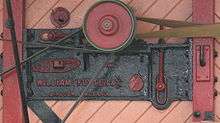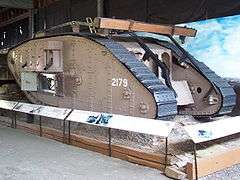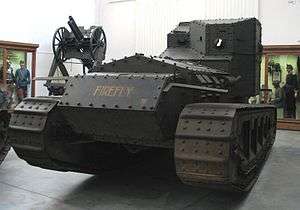William Foster & Co.
William Foster & Co Ltd was an agricultural machinery company based in Lincoln, Lincolnshire, England often called "Fosters of Lincoln." The company can be traced back to 1846, when William Foster purchased a flour mill in Lincoln. William Foster then proceeded to start small scale manufacturing of mill machinery and threshing machinery. The mill was converted to an iron foundry by 1856, thus becoming the original Wellington Foundry. By 1899 the works had moved to the Wellington foundry in New Boultham and the original works were then occupied by William Rainforth. During the First World War Fosters built some of the first tanks for the British Army.
 Foster casting on threshing mc with Tank logo cast | |
| Industry | Engineering |
|---|---|
| Fate | Purchased in 1960 by W.H. Allen, Sons and Co |
| Founded | 1846. 1877 William Foster & Co. |
| Headquarters | Waterside South, then Wellington Works, New Boultham, Lincoln, England, |
Key people | William Foster, Sir William Tritton |
| Products | Portable engines, Threshing machiness,
Traction engines, Tanks Whippet Light Tank Steamrollers, |
| Subsidiaries | Gwynnes Limited |
Agricultural machinery


The company was known for producing threshing machines, regarded as among the best available. They also made traction engines, steam tractors such as the Foster Wellington and Showman's road locomotives.
Foster were briefly involved in a deal to market tractors built by Daimler in Britain but this was dropped after the war. (Little is known about the Daimler tractors which mainly were exported).[1]
The tank

(a "Water carrier for Mesopotamia")

Foster's, as builders of agricultural machinery, were involved in the production and design of the prototype tanks.
After the First World War, The Royal Commission on Awards to Inventors decided that the principal inventors of the tank were Sir William Tritton, managing director of Fosters, and Major Walter Wilson.
An example of one of the first tanks that were used in the First World War is preserved and on display in the Museum of Lincolnshire Life. This is a Mark IV. The tanks were described as "Water carriers for Mesopotamia" during production for security.
The firm used the symbol of the tank after the war on other machinery they built as a trade mark.
Gwynnes Invincible Pumps
Gwynnes Limited manufactured centrifugal pumps from the mid 19th century in Hammersmith until acquired by Foster & Co. in 1927. Pump production was moved to Lincoln in 1930 and the company renamed Foster Gwynnes. Pump production ended in Lincoln in 1968.[2]
In 1964 vertical pumps were supplied to the Deeping fen IDB for the pumping station at Pode Hole, where they remain in use.
Takeover
The company was acquired by W.H. Allen, Sons and Co in 1960, and subsequently by Amalgamated Power Engineering.
See also
- History of the tank - General details of development & background
- Ruston & Hornsby - Fellow Lincoln Firm, builders of steam engines
- Richard Garrett & Sons - Competitor for Showmans engines.
- Clayton & Shuttleworth - Fellow Lincoln firm and builders of steam engines.
- Marshall, Sons & Co. - Fellow Lincolnshire firm, and builder of Threshing machines.
In fiction
There is a traction engine in both Rev W Awdry's Railway Series and The Thomas & Friends TV Series based on one of these named Trevor.
References
- Classic farm tractors, by Micheal Williams, ISBN 978-0753714461
- 'The Story of the Wellington Foundry, Lincoln' M R Lane
Bibliography
Evans, Gwyn (2015) A Reappraisal of Lincoln Tank Production in 1916, Lincolnshire History and Archaeology, pp 95-105.
External links
| Wikimedia Commons has media related to William Foster & Co.. |
- DVD on Fosters machines
- Photos of preserved Foster Steam Engines - Traction Time